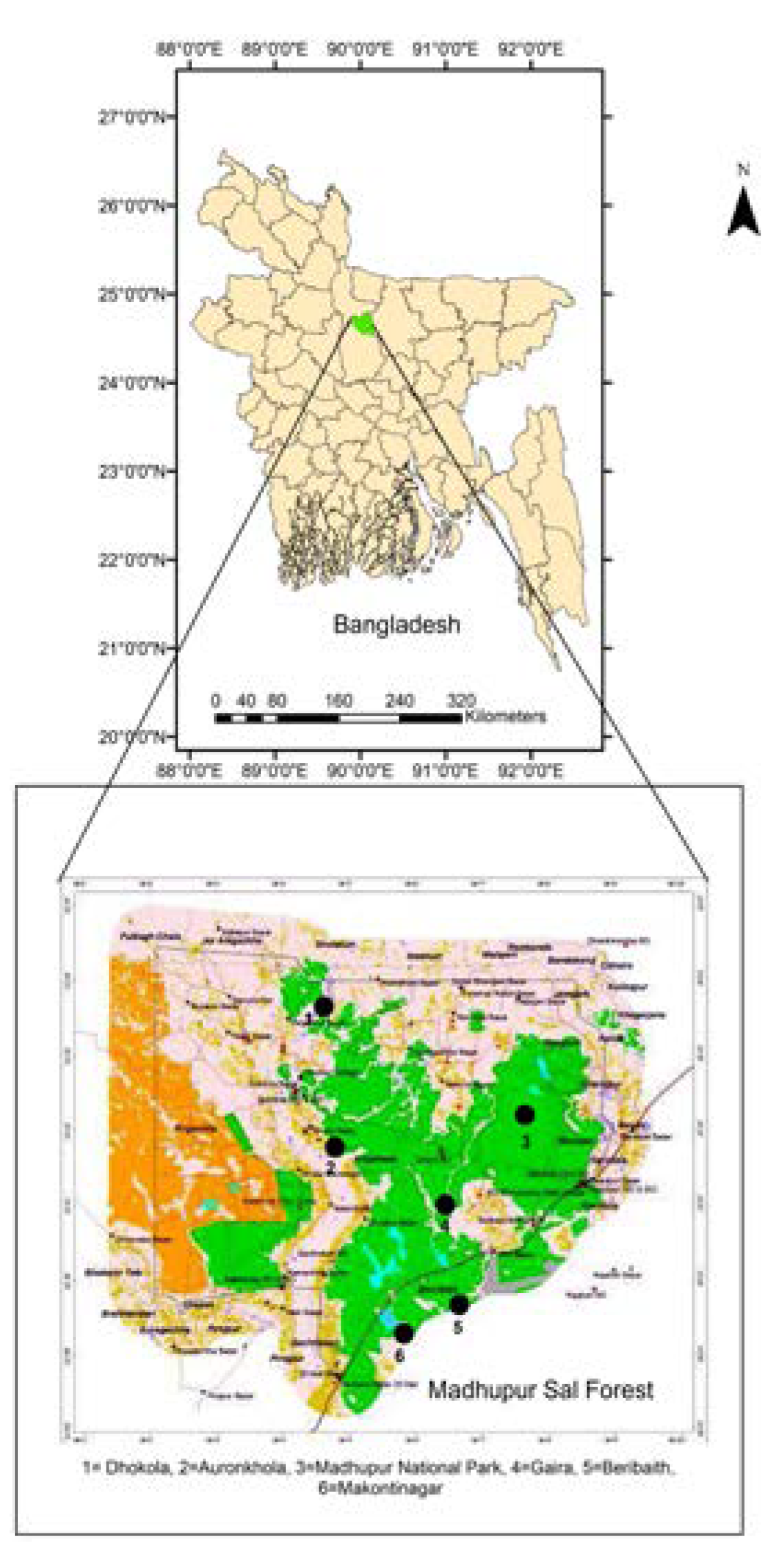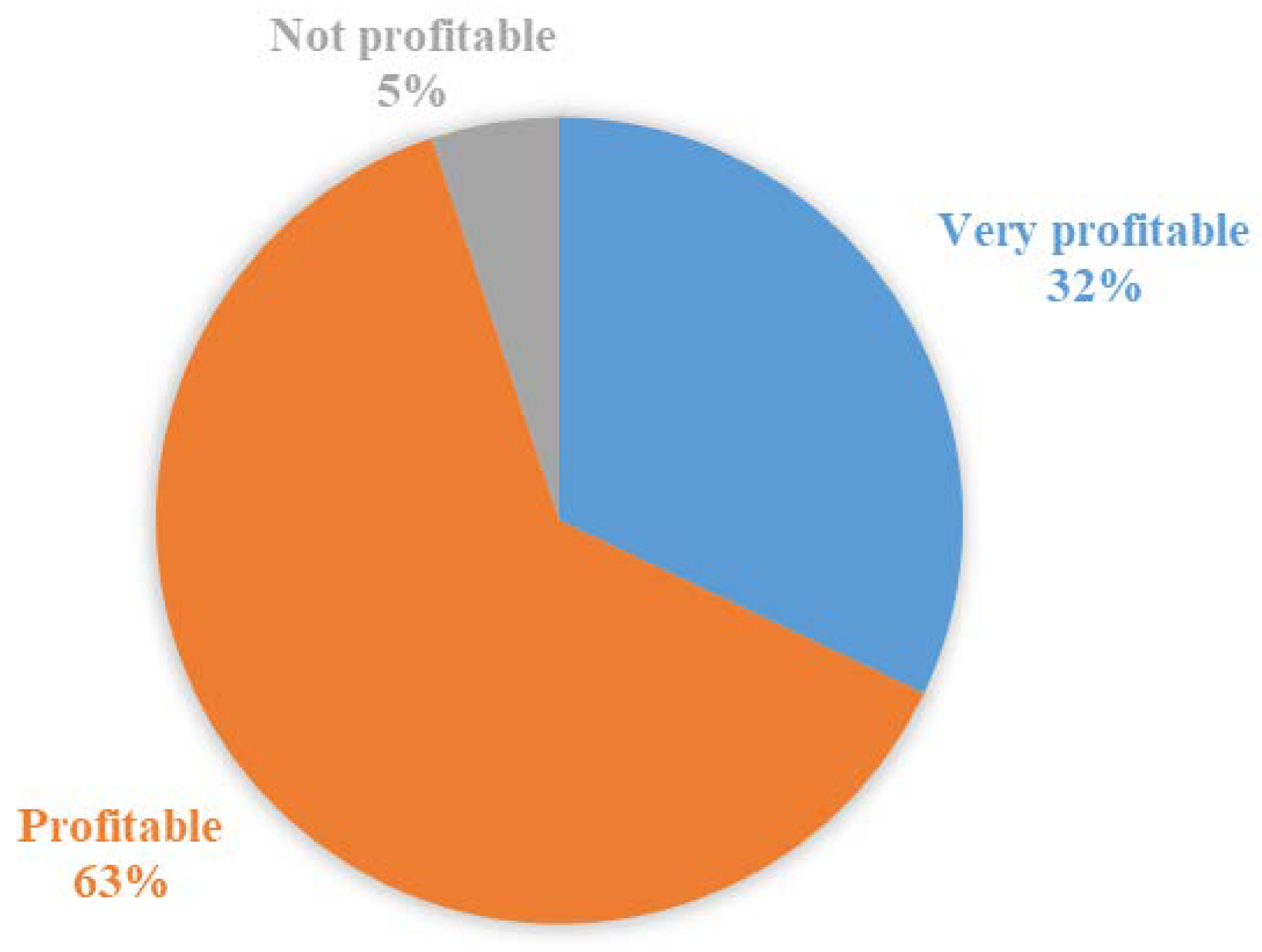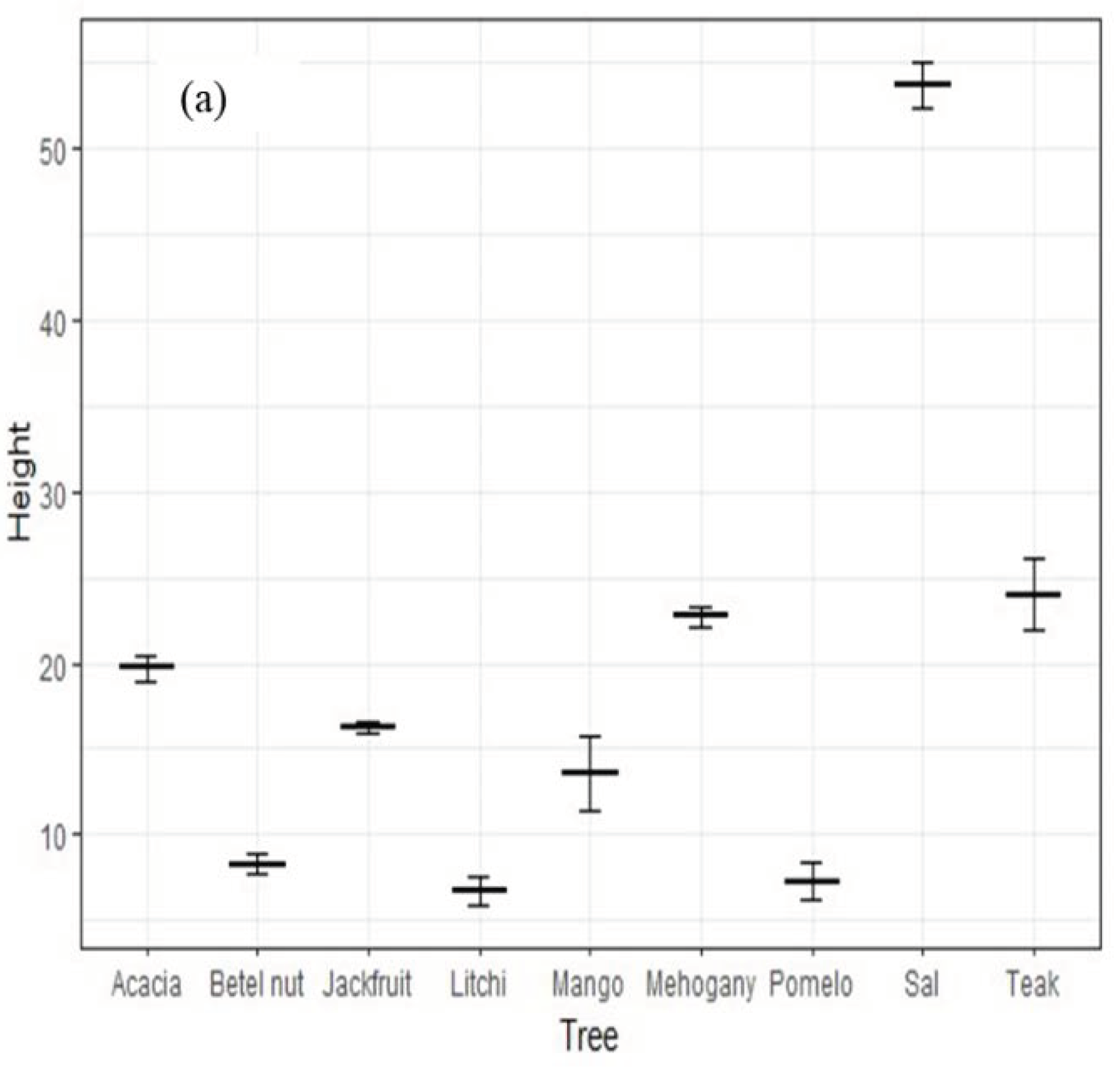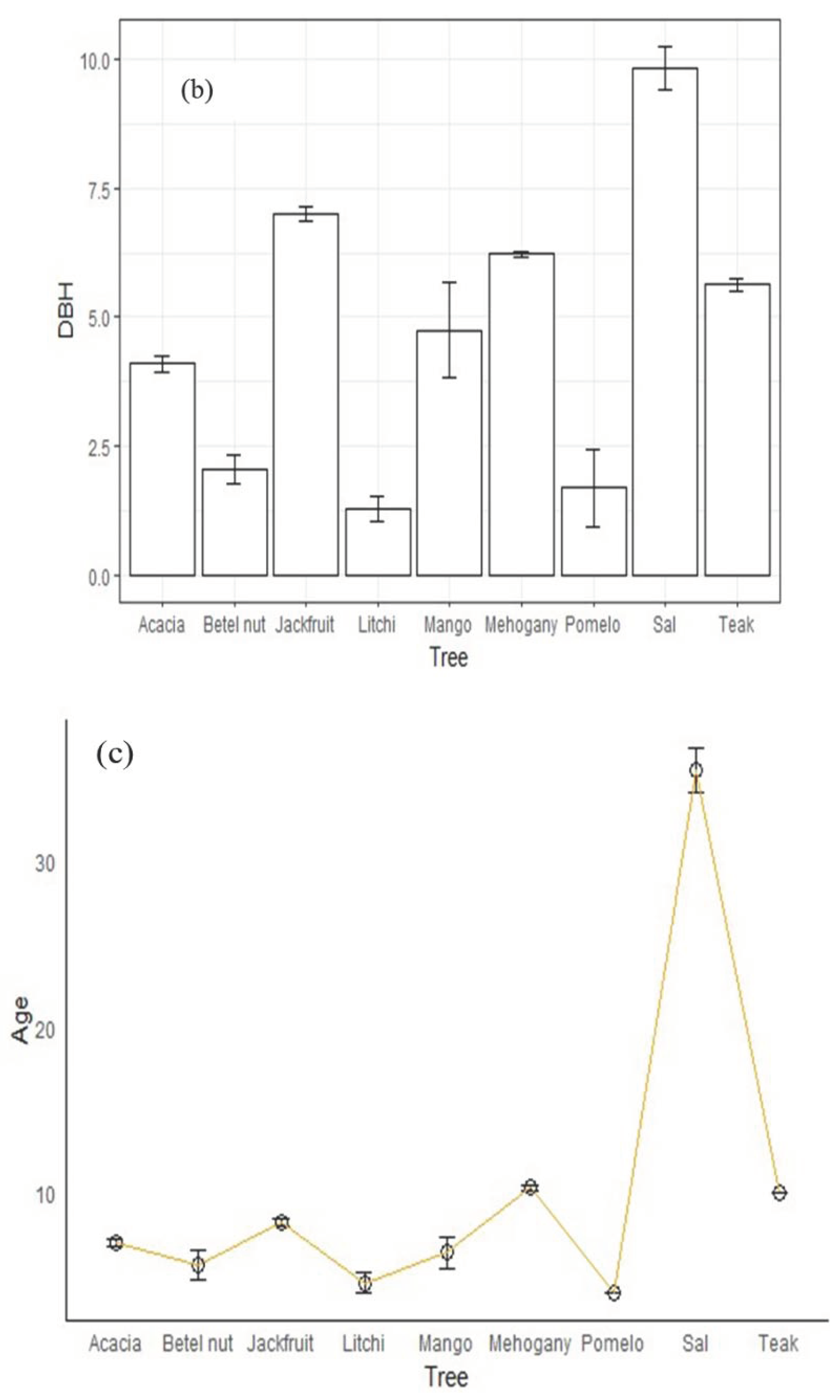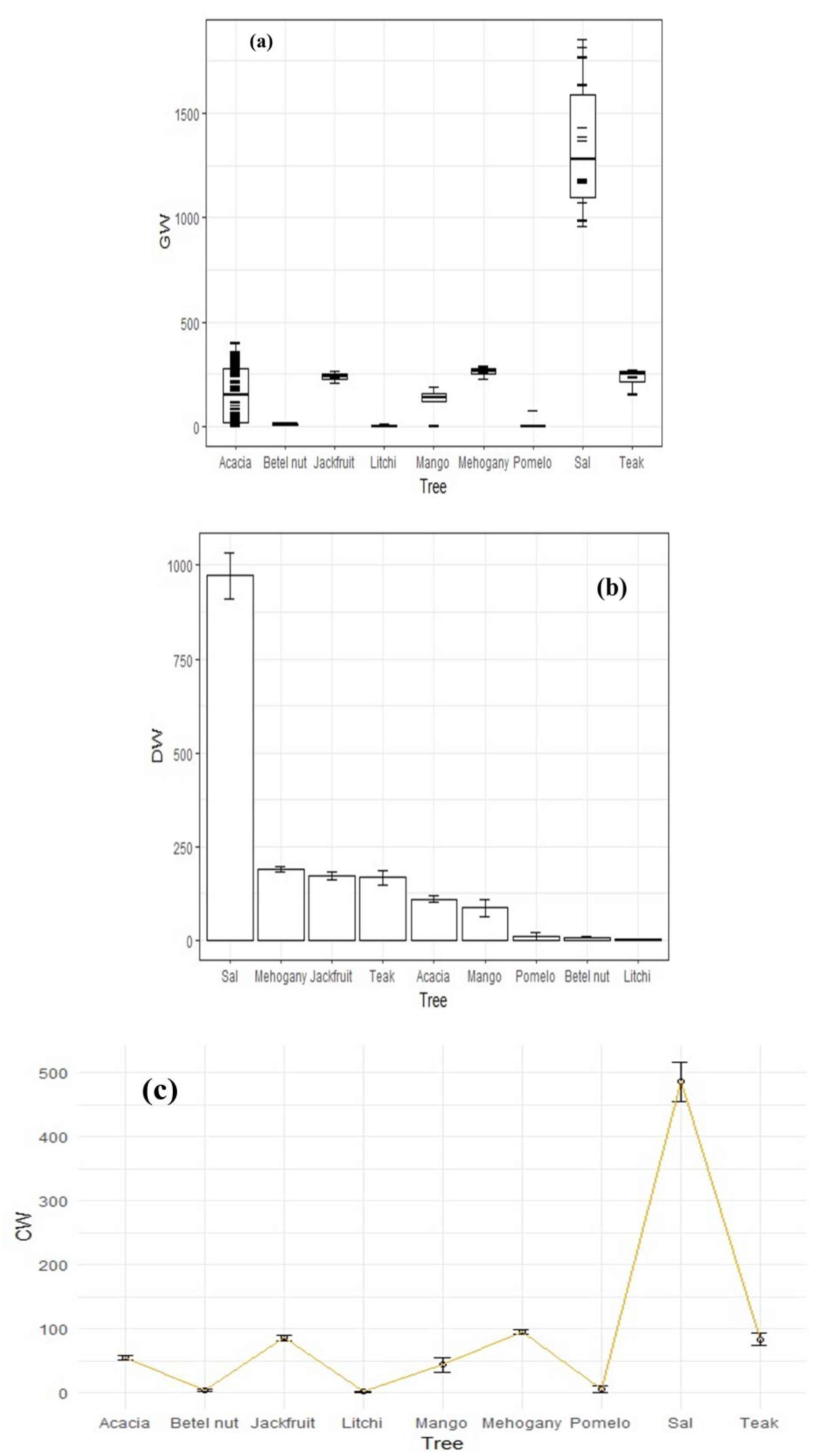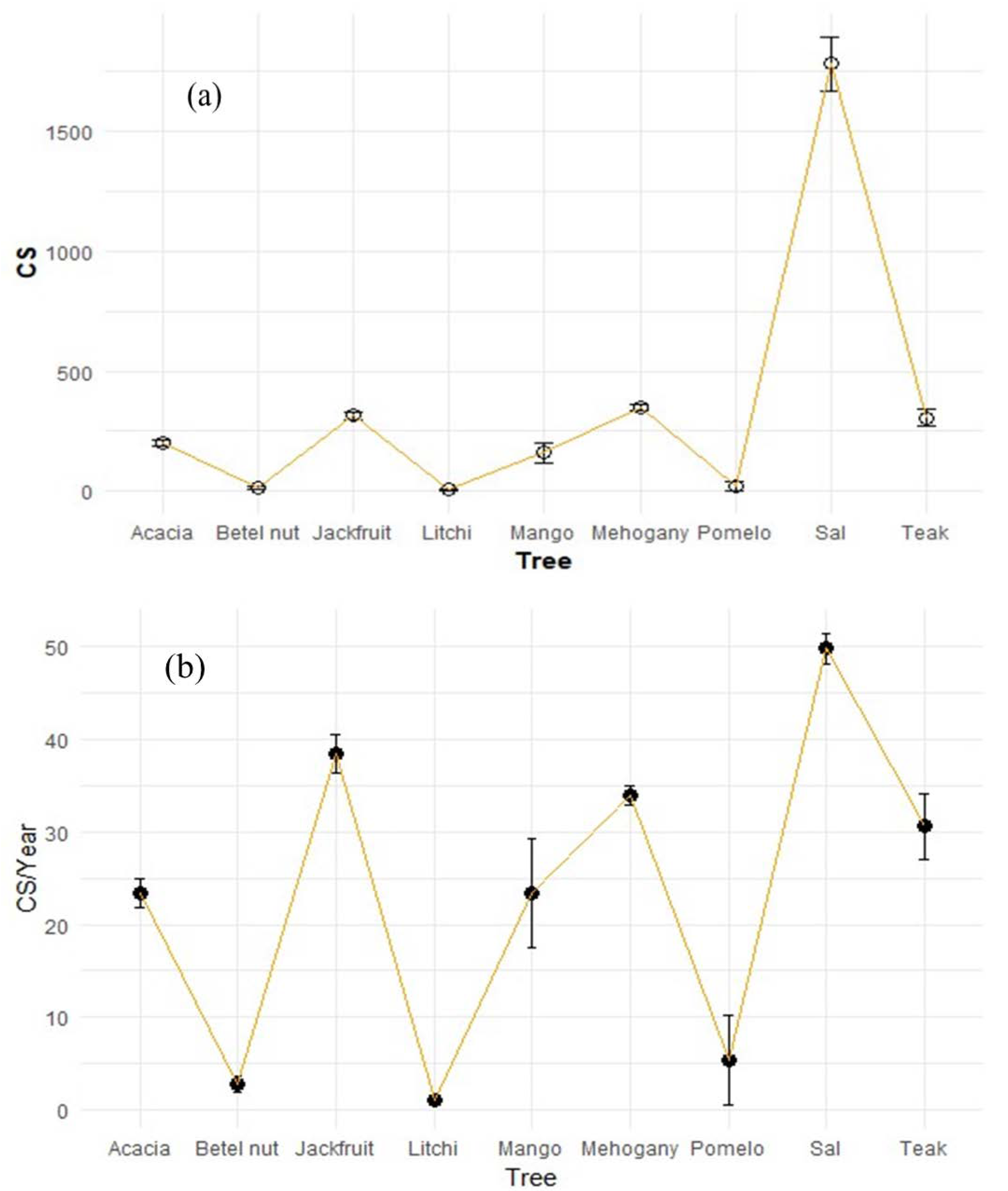1. Introduction
Agriculture is a vital driver of Bangladesh's economic growth, contributing significantly to GDP, employment, and export revenues [
1]. Despite its historical importance, the industry faces challenges such as diminishing arable land, population growth, and declining productivity. The government has implemented diverse agricultural policies to address these issues, especially in the context of climate change impacts, including rising temperatures and extreme weather events [
2]. In response to climate change challenges, agroforestry has been recognized as a viable strategy [
3]. Trees play a crucial role in mitigating climate change by capturing atmospheric carbon through photosynthesis [
4]. The Madhupur Sal forest area in Bangladesh, with prevalent Acacia-Pineapple-based agroforestry practices, serves as a promising site for studying the productivity and carbon sequestration potential of different agroforestry systems [
5].
The global rise in carbon dioxide and methane concentrations, mainly due to industrialization, underscores the importance of forests as natural climate change brakes [
6]. Madhupur Sal forest, covering a substantial portion of Bangladesh's forested territory, plays a crucial role in sequestering carbon [
7]. The estimation of the total carbon stock in Madhupur Sal forest is essential for understanding its pivotal role in mitigating climate change at both national and global levels. Bangladesh, being highly vulnerable to climate change, has experienced an increase in CO
2 levels, primarily from fossil fuel burning [
8]. Efforts to reduce CO
2 emissions include managing carbon fluxes in agricultural systems and utilizing mechanisms like the Kyoto Protocol's clean development mechanism. Forestry, particularly agroforestry, has gained global recognition as a solution to reduce CO
2 emissions, with tropical deforestation accounting for a significant portion of yearly CO
2 emissions. In Bangladesh the government recognize the importance of restore degraded Sal forest. Government Restore 137,800 ha deforested hill and plain land Sal forest and also 20,000 ha degraded hill and plain land Sal forest [
9].
While agroforestry's benefits were initially emphasized at local or regional scales, there is a growing awareness of its global environmental services, including carbon sequestration and biodiversity protection. This research aims to investigate various agroforestry systems in Madhupur Sal forest, evaluating tree and crop productivity. Assessing carbon sequestration potential is crucial for understanding agroforestry's role in climate change mitigation.
2. Materials and Methods
2.1. Study Area
The study was carried out in the Madhupur tract (45,565.2 acres), commonly known as the Madhupur Sal Forest or Madhupur Garh, In Bangladesh, moist deciduous plain land Sal forests distributed over the relatively drier central and north-western parts of the country [
10,
11]. This area is mainly made up of the districts of Tangail, Mymensingh, Gazipur, and Dhaka; of the above, it is in the Madhupur Sal forest (under Tangail and Mymensingh districts) particularly that the majority of the Sal forests exist. The Madhupur Sal forest is located in the northeastern part of the Tangail Forest Division with a small portion running along the boundary with the Mymensingh Forest Division [
12,
13].
The climate of the Madhupur Garh varies slightly from north to south, the northern reaches being much cooler in winter. Average temperatures vary from 29.3°C to 21.1°C in summer, falling to 20°C in winter, with extreme lows of 10°C. Rainfall ranges between 1,500 mm to 2,100 mm annually and the average is 2011.6 mm. Mean annual Relative Humidity (RH) and total evaporation are 84.8% and 1050 mm, respectively [
14]. The Madhupur Sal tract belongs to the Bio-ecological Zone No. 3 and the 28th AEZ (Agro-Ecological Zone) of Bangladesh [
15].
The study selected six important villages (Dhokola, Auronkhola, Madhupur National Park, Gaira, Beribaith, and Makontinagar) under three unions of the study area where ethnic people are practicing agroforestry for data collection. Three different agroforestry practices (Acacia-Pineapple-Turmeric-Papaya, Acacia-Pineapple-Zinger-Banana, and Sal-Pineapple-Aroid based) were selected to quantify the productivity and sequestration status of carbon as a whole in Madhupur Sal forest of Bangladesh.
Figure 1.
A map of Madhupur Sal forest showing the study area.
Figure 1.
A map of Madhupur Sal forest showing the study area.
2.2. Data Collection
The study used questionnaire survey techniques for collecting the economic aspects of agroforestry practices in Madhupur Sal forest area. In this process, the study randomly selected agroforestry farmers for questionnaire interviews. On the contrary, for the carbon sequestration of agroforestry practices, the study used quadrates (10 m×10 m) techniques for collecting ecological data. A 20-sample plot (10 m×10 m) was chosen at random from six different villages in the agroforestry field. For calculating carbon sequestration, tree height, DBH, and age of trees data were collected.
2.3. Calculation of Net Present Value (NPV)
The difference between the present value of all future projected cash inflows and the present value of all future expected cash outflows is the net present value. For calculating Net Present Value, at first, we identified the future benefits and then showed out the present and future costs. Then the present value of future costs and benefits were calculated. The present value factor is,
Here,
r = Discounting rate;
n = Number of years
The formula for calculating the present value is:
Present Value of Future Benefits = Future Benefits × Present Value Factor.
Calculation Net Present Value using this formula:
If the Net Present Value (NPV) is positive, the research should be undertaken. If the NPV is negative, the research should not be undertaken [
16].
2.4. Calculation of Benefit-Cost Ratio (BCR)
The benefit-cost ratio (BCR) is a monetary or qualitative statistic that shows the link between the relative costs and benefits of a proposed project. Cost-benefit analysis formula helps firms compare and calculate which research or task would offer maximum profits with minimum costs involved.
where,
Bt= Gross benefit in the nth year
Ct= Total cost in the nth year
t = Number of years (1, 2, 3………n)
r = Interest (discount) rate
If the benefit-cost ratio is greater than 1, go ahead with the research project. If the benefit-cost ratio is less than 1, should not go ahead with the research project [
17].
2.5. Calculation of Carbon Sequestration
The growth features of the tree species, the local growth circumstances where the tree is placed, and the density of the tree's wood all affect how quickly carbon gets sequestered. Even so, I can roughly estimate the quantity of CO2 a specific tree sequesters and get the annual sequestration rate by dividing it by the age of the tree. This process is:
Determination of the total (green) weight of the tree.
Determination of the dry weight of the tree.
Determination of the weight of Carbon in the tree.
Determination of the weight of carbon dioxide sequestered in the tree.
Determination of the weight of CO
2 sequestered in the tree per year [
18].
2.6. Determination of the Total (Green) Weight of the Tree
The process was used to determine the weight of a tree based on its species
W = Above-ground weight of the tree in pounds
D = Diameter of the trunk in inches
H = Height of the tree in feet
The variables D2 and H were extended to exponents above or below 1 depending on the species of tree and the coefficient (for example, 0.25) which was altered. The weight of a tree's root system typically equals 20% of its above-ground weight. To calculate the tree's total green weight, the above-ground weight of the tree was multiplied by 120% [
18].
2.7. Determination of the Dry Weight of the Tree
A suggested table was used to calculate the tree's dry weight. The average weight of a cord of wood for several tree species is listed in the table. The average tree was predicted to have 72.5% dry matter and 27.5% moisture when all tree species in the table were taken into consideration. To get the tree's dry weight, the weight of the tree was multiplied by 72.5% [
18].
2.8. Determination of the Weight of Carbon in the Tree
The average carbon content is typically 50% of the tree’s total volume. Therefore, increase the tree's dry weight by 50% to get the amount of carbon it contains [
18].
2.9. Determination of the Weight of CO2 Sequestered in the Tree
CO2 is composed of one molecule of C and two molecules of oxygen.
The atomic weight of Carbon is 12.001115
The atomic weight of Oxygen is 15.9994
The weight of CO2 is C+2*O = 43.999915
The ratio of CO2 to C is 43.999915/12.001115 = 3.6663
Therefore, to determine the weight of CO
2 sequestered in the tree, multiply the weight of carbon in the tree by 3.6663 [
18].
2.10. Determination of the Weight of CO2 Sequestered in the Tree per Year
Finally, the weight of CO2 sequestered in the tree was divided by the age of the tree to determine the weight of CO2 sequestered per year per tree. The simple equation is:
Weight of CO
2 sequestered per year = weight of CO
2 sequestered per tree/tree age …..(7)[
18].
2.11. Data Analysis
After compilation and tabulation, the data was analyzed statistically following the selected objective. When necessary, qualitative data are translated into quantitative data using appropriate grading. The data is then evaluated using Microsoft Office Excel and R studio software. The obtained data is analyzed using descriptive statistics. Percentage of tables, column charts, and pie charts were used to depict the connection between agroforestry adoptions.
3. Results
3.1. Demographic Features of the Respondents
Farmers from various age classes ranging from 20 to 85 years were involved in practicing agroforestry in Madhupur Sal forest and were again gender categorized into male (74.36%) and female (25.64%). Mostly, middle-aged farmers were growing trees with crops as they could easily indulge in labor-intensive activities for diversified cultivation. Very few farmers from the elderly, aged more than 50 years, and farmers aged below 35 years were reluctant to agroforestry. Illiteracy in the rural community has been eradicated since the mandatory literacy programs run by the Government of Bangladesh to educate society were initiated throughout the country. The literacy of most of the farmers in the area was classified among different levels that determined their willingness to practice agroforestry. As the family is the oldest social unit, the status of society is largely influenced by various dimensions of family. The majority of the farmers have medium (71.79%) in size followed by large and small families. The size of the families of the farmers does not influence their livelihood choices because most people rely on agroforestry methods for a living, regardless of how large or small their family is. Depending on the demand for the families, the area of the farms was classified which indicated that most of the farmers (64.1%) hold small-sized farms up to 1 hectare, whereas 30.77% of farmers practice agroforestry (tree planting, sowing crops, and maintenance activities, fruit-based agroforestry, homestead agroforestry, etc.) in their medium-sized farmlands. Sustainability is key to the notion of agricultural development, and a better understanding of sustainable agriculture awareness among farmers is of particular importance to researchers. The study revealed that the majority of respondents (47.44%) were highly concerned about the importance of applying sustainable agricultural practices, while 43.59% had intermediate/moderate knowledge, and only 8.97% of farmers were unaware of the fact of sustainability (
Table 1). The concept of different agroforestry practices in the area was prominently accepted by the farmers as most of the farmers (62.82%) classified the practice as profitable and another 32.05% of farmers found agroforestry as highly profitable, 5.13% of farmers defined it as not profitable and no participant told even-break by practicing agroforestry (
Figure 2).
3.2. Economic Perspective of Agroforestry Practices
The growth and maintenance of tree crop-based agroforestry practices are shaped by different aspects of economic features for the rural farmers of Bangladesh. According to the analysis of agroforestry experts on different popular agroforestry models in the study area, this study focused on the three most prominent agroforestry practices in Madhupur Sal forest of Bangladesh.
3.3. Productivity Analysis of Acacia-Pineapple-Turmeric-Papaya-Based Agroforestry
According to the economic perspective, this agroforestry system required intense agricultural labor, which was the primary input cost of the agroforestry systems that was comparatively lower for the establishment (
Table 3). However, the Acacia tree requires high-quality seedlings to build agroforestry systems, the initial sapling and tree installation expenses were higher. The total input cost of production was 2141.45 USD/hectare and the total profit was 6212.95 USD/hectare. The Net Present Value (NPV) of this agroforestry system was 1833.55 USD/hectare and the Benefit-Cost Ratio was 1.90 (
Table 3). This agroforestry system is more profitable than the general agricultural system.
3.4. Productivity Analysis of Sal-Pineapple-Aroid Based Agroforestry
As Sal (
Shorea robusta) is the most prominent species of the forest and Pineapple is widely spread in the area, Sal-Pineapple-Aroid-based agroforestry is one of the major agroforestry practices. Sal can tolerate high temperatures and usually loses its leaves from February to March, with new leaves appearing in April and May. These leaves from Sal are used for mulching so that soil can conserve moisture and leaves decompose to add soil nutrients. In this agroforestry model, the total production cost and profit were 2150.30 USD/hectare and 5745.10 USD/hectare worth a Net Present Value (NPV) of 1372.28 USD/hectare and the Benefit-Cost Ratio was 1.67 (
Table 3)
3.5. Productivity Analysis of Acacia-Pineapple-Zinger-Banana Based Agroforestry
The study analyzed nine Acacia-Pineapple-turmeric-Papaya-based agroforestry plots for detailed economic analysis and converted the findings to hectares. The total input cost of this agroforestry model was 2150.02 USD/hectare and the net profit was 4434.93 USD/hectare. However, the Net Present Value (NPV) was 2170.66 USD/hectare and the Benefit-Cost Ratio (BCR) was 2.06 (
Table 4).
3.6. Ecological Perspective of Selected Agroforestry Practices
3.6.1. Species Composition of Agroforests
A total of 9 tree species that were planted with diverse crops in the agroforestry model were observed, totaling 173 trees in the Madhupur Sal forest. The forest is enriched with Sal (Shorea robusta), where Acacia (Acacia auriculiformis) species were mostly planted in association followed the availability of Teak (Tectona grandis), Litchi (Litchi chinensis), and Jackfruit (Artocarpus heterophyllus). The average height of the tree was 19.7ft, DBH (Diameter Breast Height) 4.1 inches, and age 7 years for Acacia (Acacia auriculiformis). The average height of the tree ranged from 6.5ft to 54ft for Mango (Mangifera indica), Jackfruit (Artocarpus heterophyllus), Teak (Tectona grandis), Mahogany (Swietenia macrophylla), Litchi (Litchi chinensis), Pomelo (Citrus maxima), Betel nut (Areca catechu), Sal (Shorea robusta). The average age of the tree varied from 4.5 years to 36 years for Pomelo (Citrus maxima), Betel nut (Areca catechu), Teak (Tectona grandis), Mango (Mangifera indica), Jackfruit (Artocarpus heterophyllus), Sal (Shorea robusta) whereas average diameter was 1.5 to 13 inches. Different trees showed various carbon sequestration due to trees' height, diameter, and age. Furthermore, particular tree management techniques influence the rate of Carbon Sequestration (CS) by urban trees.
3.7. Weight of the Trees
The average green weight of the trees varies from 4.5 lbs for Litchi (
Litchi chinensis) to 1342 lbs for Sal (
Shorea robusta) while the average dry weight varies from 3.27 lbs for Litchi (
Litchi chinensis) to 972.71 lbs for Sal (
Shorea robusta). The average carbon weighs 1.62 lbs for Litchi (
Litchi chinensis) to 486.36 lbs for Sal (
Shorea robusta). The average green weight, dry weight, and carbon weight of Acacia (
Acacia auriculiformis) were 151.18 lbs, 109.60 lbs, and 54.80 lbs respectively mostly observed in agroforestry practices (
Figure 4). The green weights of Mango (
Mangifera indica), Teak (
Tectona grandis), and Mahogany (
Swietenia macrophylla) were 120.42 lbs, 230.48 lbs, and 262.69 lbs respectively. Concerning green weight, dry weight and carbon weight, Litchi (
Litchi chinensis), Pomelo (
Citrus maxima), Betel nut (
Areca catechu) had minimum carbon sequestration and Sal (
Shorea robusta), Mahogany (
Swietenia macrophylla), Jackfruit (
Artocarpus heterophyllus), Acacia (
Acacia auriculiformis) showed maximum carbon sequestration.
3.8. Carbon Sequestration of Various Tree Species
The result showed Sal (
Shorea robusta) is the maximum carbon-sequestrating tree and Betel nut (
Areca catechu), Litchi (
Litchi chinensis), and Pomelo (
Citus maxima) are the minimum CO
2 sequestrating trees (
Figure 5). Shorea robusta sequesters average 1783.83 lbs of carbon dioxide, however,
Acacia auriculiformis 200.92 lbs
, Litchi chinensis 6 lbs,
Swietenia macrophylla 349.12 lbs,
Tectona grandis 306.31 lbs,
Artocarpus heterophyllus 316.16 lbs,
Mangifera indica 160.04 lbs of carbon was sequestrated in Madhupur Sal forest (
Figure 5). The maximum yearly CO
2 sequestration was 49.80 lbs/year for
Shorea robusta and 31.84 lbs/ year for
Tectona grandis and the minimum CO
2 sequestration was 4.43 lbs/year and 1.15 lbs/year for
Citus maxima and
Litchi chinensis (
Figure 5). Acacia auriculiformis yearly sequestrate 23.35 lbs of CO
2.
4. Discussion
It is conceivable to capture approximately 250 to 500 million tons of carbon dioxide annually in the United States, and on a global scale, this figure could reach upwards of 2,000 million tons per year for several decades [
19]. According to Toochi (2018), Northeastern maple–beech–birch forests exhibit carbon sequestration rates of 1,760 lbs of CO
2 per acre per year for a 25-year-old forest and 3,909 lbs of CO
2 per acre per year for a 120-year-old forest. Additionally, these forests sequester 2.52 lbs of CO
2 per tree per year for a 25-year-old forest and 5.58 lbs of CO
2 per tree per year for a 120-year-old forest. In contrast, white and red pine forests sequester 14 lbs of CO
2 per tree per year for a 25-year-old forest and 11.7 lbs of CO
2 per tree per year for a 120-year-old forest [
20].
In Bangladesh, roadside plantations demonstrate the highest above-ground carbon sequestration rate at 165.81 Mg C ha
−1, surpassing institutional plantations at 150.00 Mg C ha
−1. Among natural forests, protected areas accumulate the highest above-ground carbon at 195.8 Mg C ha
−1, followed by mangroves at 76.80 Mg C ha
−1. The estimated below-ground carbon for fast-growing species is 100.84 Mg C ha
−1, compared to above-ground carbon at 110.25 Mg C ha
−1 [
21]. Mangrove forests have a carbon stock of approximately 117 Mg C ha
−1, bamboo stands at 52 Mg C ha
−1, palm at 22 Mg C ha
−1, institutional plantations at 174 Mg C ha
−1, fragmented forests at 33 Mg C ha
−1, home gardens at 52 Mg C ha
−1, and protected areas at 233 Mg C ha
−1 [
22,
23,
24,
25,
26,
27].
Two unresolved issues could significantly impact the effectiveness of carbon sequestration in greenhouse gas mitigation programs, with potential counteracting effects. Firstly, the secondary benefits of converting agricultural land to forests might outweigh the costs, making carbon sequestration a no-regrets strategy. On the other hand, if leakage is a serious issue at both national and international levels, governments may invest substantial funds in subsidies or incentives, resulting in little or no net gain in carbon, forests, or secondary benefits [
19].
In Denmark, LER values ranged from 1.36 to 2.00, indicating that agroforestry systems were 36–100% more productive compared to monocultures. The agroforestry gross margin in Denmark was lower at €112 ha
−1 year
−1 compared to the United Kingdom's €5083 ha
−1 year
−1, and the crop component yielded higher returns than the tree component in agroforestry [
28]. In Europe, the primary productive advantages of agroforestry systems are associated with improved resource utilization in spatial and temporal scales, leading to enhanced environmental benefits such as reduced nutrient losses, increased carbon sequestration, biodiversity enhancement, soil loss reduction, and fire risk management in specific areas. These advantages can provide significant social benefits at the farm level across different biogeographic regions in Europe, benefiting the general public [
29].
Regarding the impact of agroforestry interventions, Castle et al. (2021) found positive or neutral effects on dietary diversity and food intake. While there is limited evidence on the environmental outcomes of agroforestry interventions, available studies suggest that environmental benefits are being achieved to some extent, aligning with the broader literature on agroforestry practices. The evidence base is insufficient to assess the interaction between environmental and social impacts. Studies did consider variable impacts across different population sub-groups, revealing that smallholder farmers typically experience the most positive effects from agroforestry interventions. Impacts on women and poorer groups varied relative to men and richer households, emphasizing the importance of considering these groups in intervention design [
30].
5. Conclusions
The multitude of agroforestry systems, whether practiced in the tropics or temperate regions, are firmly based on strong ecological principles and avail to the achievement of many local development goals through the provision of many basic needs and ecosystem services. Due to the favorable economic and ecological effects of Acacia-Pineapple-Turmeric-Papaya, Sal-pineapple-Aroid, and Acacia-Pineapple-Zinger-Banana agroforestry, these agroforestry models should garner more attention at a national and worldwide level in terms of sustainable land-use techniques. For typically resource-poor agroforestry farmers, trading of the sequestered C is a feasible possibility for economic advantage and mitigating greenhouse gases. The findings of this study will encourage both locally and internationally to implement additional legislative changes that will improve the sustainability of agroforestry systems. The management of trees in the Madhupur Sal forest can help reduce emissions of greenhouse gas and sequester carbon, and carbon sequestration by trees may make it possible for a developing country like Bangladesh to engage in carbon trading.
Author Contributions
All authors contributed to the study conception and design. Kazi Kamrul Islam and Md Tanbheer Rana guide us to prepare the materials. Material preparation and data collection were performed by Mst. Sohela Afroz, S. M. Kamran Ashraf, Saleha Khatun Ripta, S. M. Sanjida Tasnim Urmi and Sumaiya Binte Rahman Asha. The first draft of the manuscript was written by Mst. Sohela Afroz and all authors commented on previous versions of the manuscript. All authors read and approved the final manuscript.
Funding
This research was funded by University Grants Commission of Bangladesh (Project No. 2023/76/UGC).
Data Availability Statement
All data generated or analyzed during this study are included in this article.
Acknowledgments
The author would like to thanks Ministry of Science and Technology, Government of the People`s Republic of Bangladesh for providing financial support to carry out the research. The author also expresses her special thanks to the University Grants Commission of Bangladesh (Project No. 2023/76/UGC) for providing the support for field research. The author expresses her heartiest gratefulness to the staff of the Department of Agroforestry, Bangladesh Agricultural University, for their help.
Conflicts of Interest
The authors declare no conflicts of interest.
References
- Mankhin, B.; Khan, A.; Begum, E.R.; Hossain, M.I. Market attractiveness of pineapple and banana agroforestry systems of Madhupur Sal (Shorea robusta) forest: A sustainable way of generating income and conserving forests. Journal of Agriculture and Food Research 2023, 11, 100475. [CrossRef]
- Asaduzzaman, M.; Ringler, C.; Thurlow, J.; Alam, S. Investing in crop agriculture in Bangladesh for higher growth and productivity, and adaptation to climate change. Paper presented at Bangladesh Food Security Investment Forum, Dhaka 2010.
- Verchot, L.V., Van Noordwijk, M., Kandji, S. et al. Climate change: linking adaptation and mitigation through agroforestry. Mitig Adapt Strat Glob Change 2007, 12, 901–918. [CrossRef]
- Islam, K. K., Fujiwara, T., & Hyakumura, K. (2022). Agroforestry, livelihood and biodiversity nexus: The case of Madhupur Tract, Bangladesh. Conservation, 2(2), 305-321. [CrossRef]
- Hangarge, L.M.; Kulkarni, D.K.; Gaikwad, V.B.; Mahajan, D.M. Chaudhari, N. Carbon sequestration potential of tree species in Somjaichi Rai (Sacred grove) at Nandghur village, in Bhor region of Pune District, Maharashtra State, India. Annals of Biological Research 2012, 3(7), 3426-3429.
- Gibbs, H.K.; Brown, S.; Niles, J.O.; Foley, J.A. Monitoring and estimating tropical forest carbon stocks: making REDD a reality. Environmental Research Letters 2007, 2, 13. [CrossRef]
- Ministry of Environment, Forest and Climate Change, Nationally Determined Contributions (NDCs) 2021 Bangladesh, 2021.
- Khurana, P. A study on carbon sequestration in natural forests of India. Journal of Applied and Natural Science 2012, 4(1), 132-136. [CrossRef]
- Peters, G.P.; Marland, G.; Le Quéré, C.; Boden, T.; Canadell, J.G. Raupach, M.R. Rapid growth in CO2 emissions after the 2008–2009 global financial crisis. Nature Climate Change 2012, 2(1), 2. [CrossRef]
- Islam, K.K.; Sato, N. Participatory forestry in Bangladesh: Has it helped to increase the livelihoods of Sal forests dependent people. South. For. 2012, 74, 89–101. [CrossRef]
- Islam, K.K.; Jose, S.; Tani, M.; Hyakumura, K.; Krott, M.; Noriko, S. Does actor power impede outcomes in participatory agroforestry approach? Evidence from Sal forests area, Bangladesh. Agroforest Syst 2015, 89(5), 885-899. [CrossRef]
- Muhammed, N.; Koike, M.; Haque, F.; Miah, M.D. Quantitative assessment of people oriented forestry in Bangladesh: A case study from Tangail Forest Division. J. Environ. Manage. 2008, 88(1), 83-92. [CrossRef]
- Islam, K.K.; Hyakumura, K. Forestland concession, land rights and livelihood of ethnic minorities: the case of the Madhupur Sal forest, Bangladesh. Forests 2019, 10, 288.
- NSP (Nishorgo Supported Project). Framework Management Plan for Madhupur National Park. Nishorgo Bangladesh. Available online: http://nishorgo.org/ (accessed on 16 October 2022). (accessed on null).
- . Roy, M. K. Designing a co-management model for protected areas of Bangladesh. In Proceedings of the International Seminar on protected area management, University of Montana, USA 2004.
- Tulsian, P.C. Financial Management, 2nd Revised Edition, S.Chand and Company Ltd, New Delhi 2010, 3.1-3.164.
- Blank, L.T.; Tarquin, J.A. Engineering Economy, 3rd Edition, McGraw-Hill, Inc., New York 1989.
- County, B. How to calculate the amount of CO2 sequestered in a tree per year 2012.
- Richards, K. R.; Stokes, C. A review of forest carbon sequestration cost studies: a dozen years of research. Climatic change. 2004, 63(1-2), 1-48. [CrossRef]
- Toochi, E. C. Carbon sequestration: how much can forestry sequester CO2. Forestry Research and Engineering: International Journal 2018, 2(3), 148-150.
- Majumder, S. C.; Islam, K.; Hossain, M. M. State of research on carbon sequestration in Bangladesh: a comprehensive review. Geology, Ecology, and Landscapes 2019, 3(1), 29-36. [CrossRef]
- Kamruzzaman, M.; Ahmed, S.; Paul, S.; Rahman, M. M.; Osawa, A. Stand structure and carbon storage in the oligohaline zone of the Sundarbans mangrove forest, Bangladesh. Forest Science and Technology 2018, 14, 23–28. [CrossRef]
- Sohel, M. S. I.; Alamgir, M.; Akhter, S.; Rahman, M. Carbon storage in a bamboo (Bambusa vulgaris) plantation in the degraded tropical forests: Implications 2015.
- Dey, A.; Islam, M.; Masum, K. M. Above ground carbon stock through palm tree in the homegarden of Sylhet City in Bangladesh. Journal of Forest and Environmental Science 2014, 30, 293–300. [CrossRef]
- Islam, M.; Deb, G. P.; Rahman, M. Forest fragmentation reduced carbon storage in a moist tropical forest in Bangladesh: Implications for policy development. Land Use Policy 2017, 65, 15–25. [CrossRef]
- Jaman, M. S.; Hossain, M. F.;
- M. S.; Helal, M. G. J.; Jamil, M. Quantification of carbon stock and tree diversity of homegardens in Rangpur District, Bangladesh. International Journal of Agriculture and Forestry 2016, 6, 169–180.
- BFD. Official website of Bangladesh Forest Department 2018.
- Lehmann, L. M.; Smith, J.; Westaway, S.; Pisanelli, A.; Russo, G.; Borek, R.; Ghaley, B. B. Productivity and economic evaluation of agroforestry systems for sustainable production of food and non-food products. Sustainability 2020, 12(13), 5429. [CrossRef]
- Rigueiro-Rodríguez, A.; Fernández-Núñez, E.; González-Hernández, P.; McAdam, J. H., Mosquera-Losada, M. R. Agroforestry systems in Europe: productive, ecological and social perspectives. Agroforestry in Europe: current status and future prospects 2009, 43-65.
- Castle, S. E.; Miller, D. C.; Ordonez, P. J.; Baylis, K.; Hughes, K. The impacts of agroforestry interventions on agricultural productivity, ecosystem services, and human well-being in low-and middle-income countries: A systematic review. Campbell Systematic Reviews 2021, 17(2), e1167.
|
Disclaimer/Publisher’s Note: The statements, opinions and data contained in all publications are solely those of the individual author(s) and contributor(s) and not of MDPI and/or the editor(s). MDPI and/or the editor(s) disclaim responsibility for any injury to people or property resulting from any ideas, methods, instructions or products referred to in the content. |
© 2024 by the authors. Licensee MDPI, Basel, Switzerland. This article is an open access article distributed under the terms and conditions of the Creative Commons Attribution (CC BY) license (http://creativecommons.org/licenses/by/4.0/).
